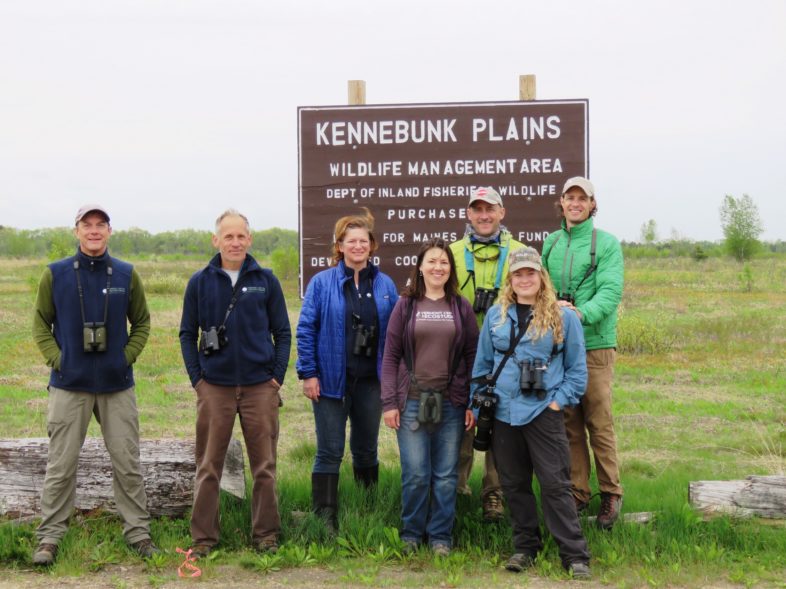
The Green Mountain Goatsuckers: from left, Steve Faccio, Chris Rimmer, Susan Hindinger, Sarah Carline, John Lloyd, Troi Perkins, and Jason Hill.
Ten years after the Green Mountain Goatsuckers’ first birdathon visit to the seacoast of southern Maine, we returned for a repeat performance in 2017. Drawn by the region’s infamous rugged shoreline, hidden sandy beaches, extensive salt marshes, and varied upland habitats—not to mention great seafood and a stellar place to stay—we were all excited to encounter some sea- and shorebirds that we rarely get to see in Vermont.
Five of our seven-member team, consisting of Chris Rimmer, Susan Hindinger, Steve Faccio, Sarah Carline and Troi Perkins, arrived at the Rimmer family’s “Spouting Rock Cottage” at 5:45 on a calm,
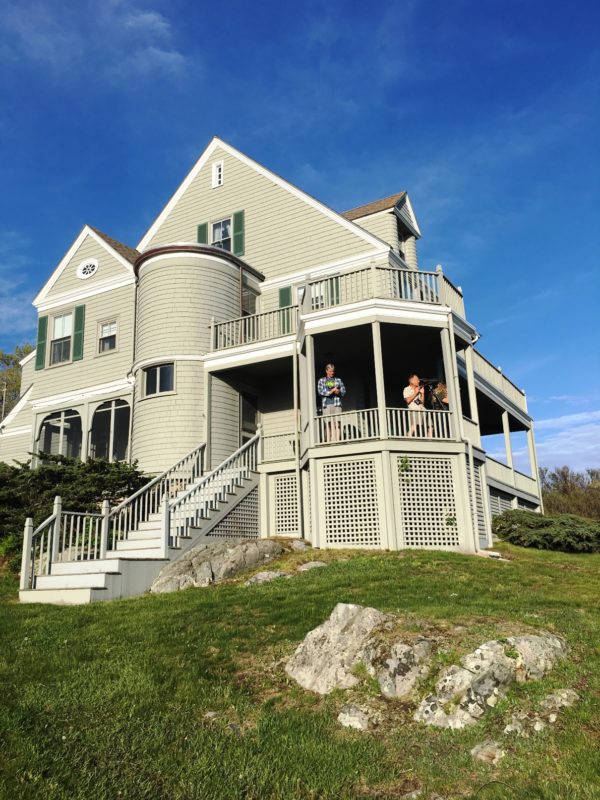
Spouting Rock Cottage in late afternoon sunlight. Photo by Susan Hindinger
sunny, and warm afternoon. Wasting no time, our 24-hour birdathon commenced at 6pm on the spacious porch overlooking the Gulf of Maine near the mouth of the Kennebunk River. The “cottage,” which has been in Chris’s family since 1925, provided an ideal base of operations, and we quickly ticked off Common Eider, Double-crested Cormorant, Herring and Great Black Backed Gulls, and Black-crowned Night Heron, along with several landbirds singing in the shrubs around the yard. Chris, who spent many youthful summers in this grand house and still visits as often as possible, knows the local birdlife well, and in no time spotted a Northern Gannet flying about a mile offshore, in addition to a Red-throated Loon and a raft of sea ducks that included both Black and White-winged Scoters. By 6:30pm, John Lloyd and Jason Hill (the remaining two members of the Goatsuckers) arrived, and while strolling around the yard confirmed both Blackpoll Warbler and a potential breeding pair of Chimney Swifts entering the Rimmer chimney (the same chimney upon which a Snowy Owl perched frequently in the spring of 2015!). As dusk approached we were lucky enough to spot two Common Nighthawks winging their way south over the Gulf. We ended our “porch sit” at nightfall with a total of 33 species, opting to pursue lobster, mussels, and salad instead of owls, woodcock, and snipe!
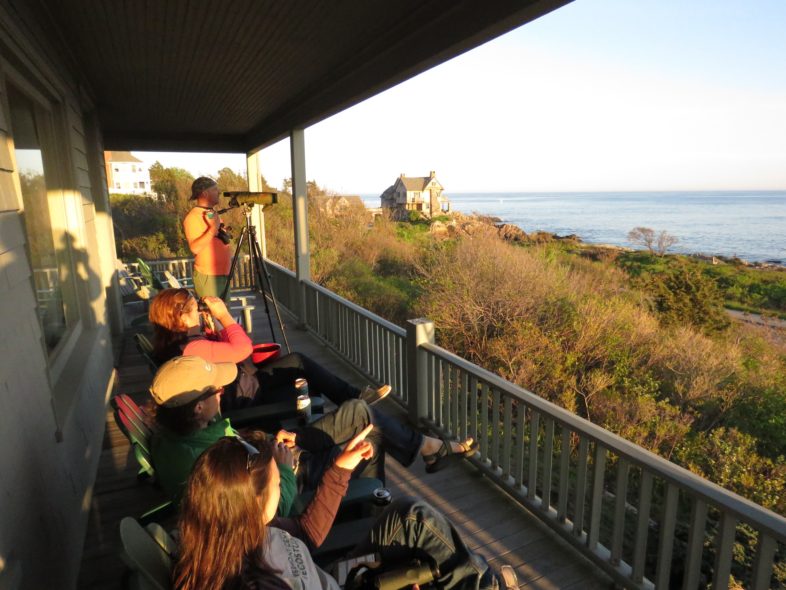
Evening porch birding on the Gulf of Maine. Photo by Steve Faccio
We arose bright and early the next morning, grabbed some freshly brewed coffee and were out the door by 0500—next stop, Biddeford Pool. The group made the short walk out to East Point Sanctuary, a rocky headland owned by Maine Audubon, where we were treated to a quick flyby sighting of a Merlin, along with numerous landbirds, including a Ruby-throated Hummingbird, and Barn and Tree Swallows. Although the skies were cloudy, it was still calm, providing good conditions for scoping a variety of sea- and waterbirds, including Black Guillemots, Red-breasted
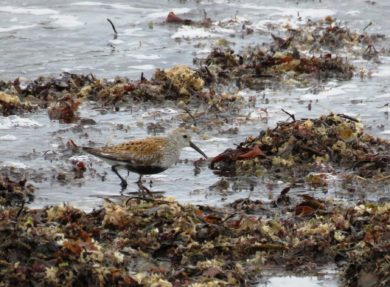
Dunlin. Photo by Steve Faccio
Merganser, Surf Scoter, a Ring-billed Gull, and hundreds of Common Terns. We stopped at several other viewing locations around Biddeford Pool where we added Eastern Kingbird, Eastern Phoebe, and Downy Woodpecker, along with Great Egret, and Common Loon. Biddeford Pool Beach provided our first good shorebirding of the day, where we found Black-bellied and Semipalmated Plovers, Ruddy Turnstones, and Willets, in addition to a Snowy Egret. At nearby Fortunes Rock Beach, we added Dunlin, a Least Sandpiper, and were fortunate to find three Purple Sandpipers roosting on the rocks. We then moved on to a broad sandy beach in Kennebunkport where we added an Osprey, a pair of Red-tailed Hawks, Greater Yellowlegs, and several Piping Plovers, including an incubating female.
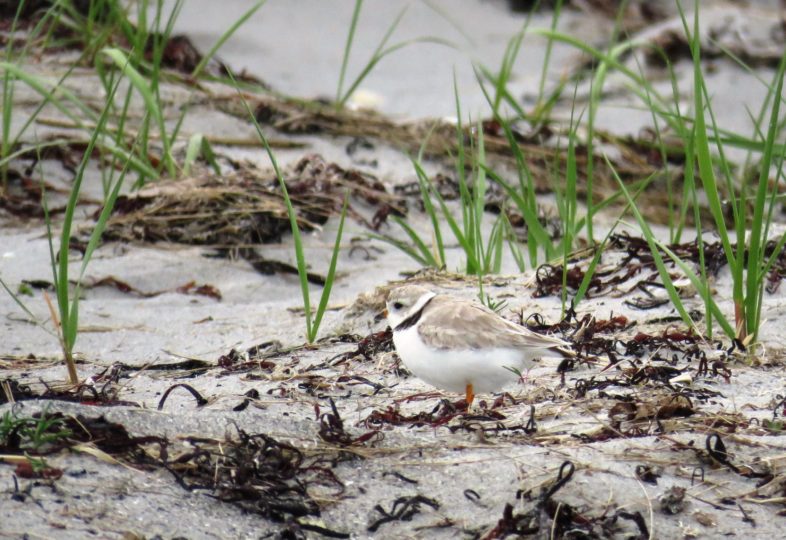
Piping Plover. Photo by Steve Faccio
Next stop was the Timber Point Trail at Rachel Carson National Wildlife Refuge, which weaves through a variety of woodland, wetland, and shrub habitats before reaching the shore. Here we added Eastern Bluebird, Wood Thrush, Northern Parula, Black-throated Green Warbler, Savannah and Swamp Sparrows, Rose-breasted Grosbeak, and a singing Purple Finch. We then decided it was time to move inland, but first agreed that a quick “refueling” stop was in order. Outside a local bakery, where the team’s dining choices ranged from quiche, to croissant, to soup, with coffees all around, we heard the nasal calls of Fish Crows.
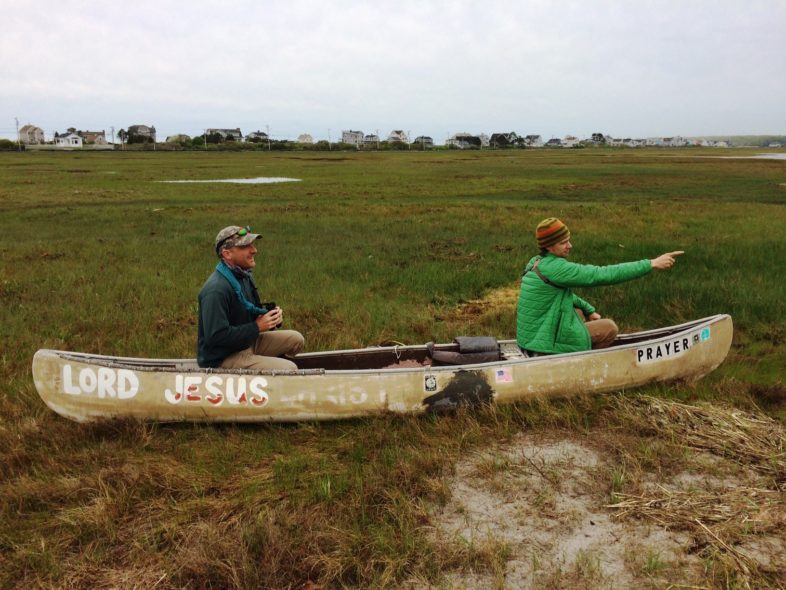
Praise the Lord, here comes the tide! John Lloyd and Jason Hill take alternative transportation. Photo by Steve Faccio
Feeling refreshed and ready for a change of pace, we soon arrived at the Kennebunk Plains Wildlife Management Area. This unique and ecologically important area consists of over 1,700 acres of sand plains and pine barrens habitat surrounded by upland forest. The site supports a variety of
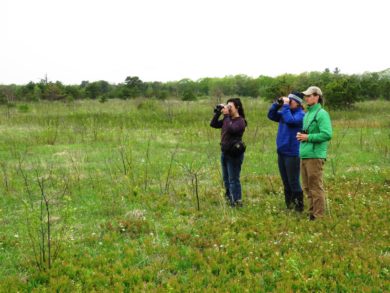
Sarah Carline, Susan Hindinger, and Jason Hill birding on the Kennebunk Plains. Photo by Steve Faccio
rare species, including Eastern Black Racer and Blandings Turtle, but we were there primarily for the grassland birds—and we were not disappointed. Within 50 meters of leaving our vehicles we heard wolf-whistle calls of displaying Upland Sandpipers, which we saw and heard frequently over the next 2.5 hours. We also confirmed most of the other grassland specialists of the area, including Grasshopper, Field, Vesper, and Savannah Sparrows, Eastern Towhee, Eastern Meadowlark, and Prairie Warbler. In the adjacent upland forest we found Veery, Ovenbird, and Black-and-White, Magnolia, and Pine Warblers, along with Scarlet Tanager. By the time we got back to our cars the clouds were noticeably thicker, and intermittent, light showers were just beginning to fall.
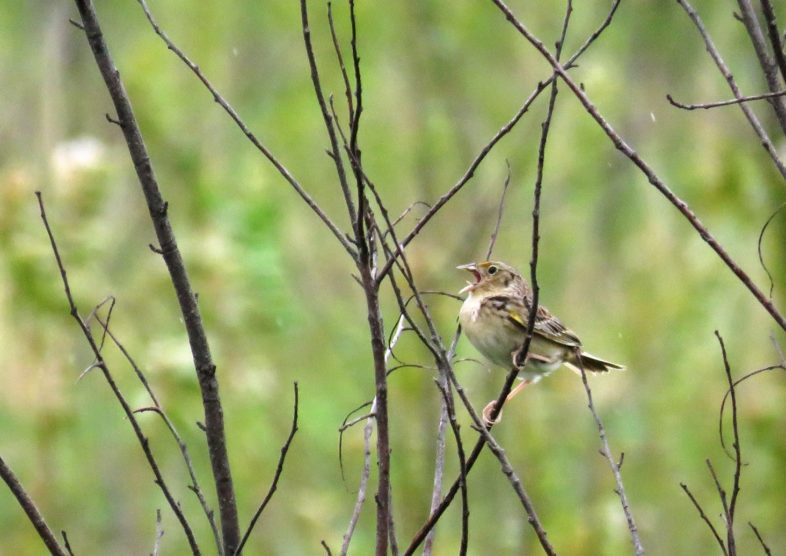
A Grasshopper Sparrow belts out its insect-like song. Photo by Steve Faccio
While driving to our next stop we picked up Bobolink in a roadside hayfield, followed by a singing American Redstart. Soon after, both Steve and Sarah heard the distinctive phrase from a Blue-headed Vireo through the car’s open window. Stopping immediately to investigate, Steve noticed a brown, thrush-sized bird skulking in the roadside thickets, which upon further investigation turned out to be a Black-billed Cuckoo that was busy feeding on tent caterpillars.
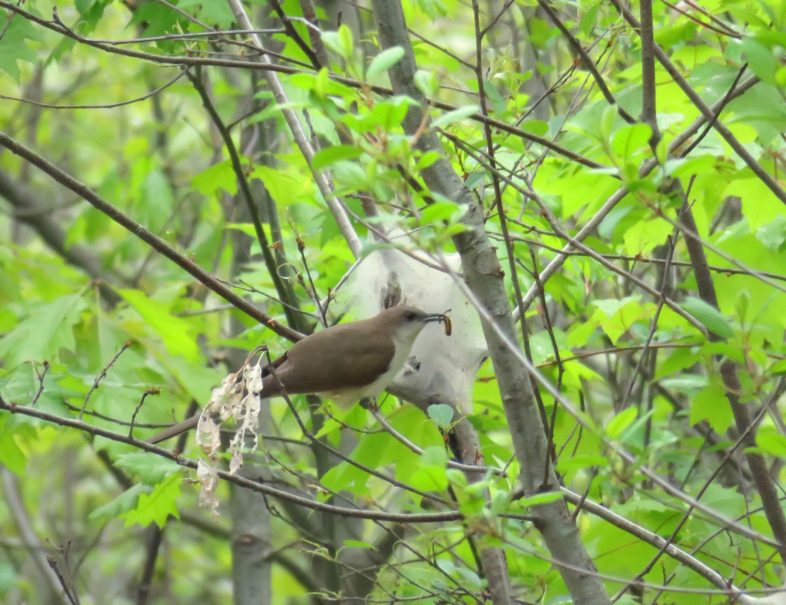
Black-billed Cuckoo feeding on tent caterpillars. Photo by Steve Faccio
By 3:30pm we arrived at Laudholm Farms in a steady rain, where we were treated to close-up views of a displaying group of Wild Turkeys. With rain pouring down, we made a few more stops on the way back to the cottage, picking up Bald Eagle and Great Blue Heron, but missing out on some sure bets, such as Northern Flicker, Belted Kingfisher, and Hermit Thrush. Topping out at 111 species, we called it a day a little bit early, satisfied with our tally and having seen a suite of species we rarely get to see on our typical Vermont-based birdathons.
See the full list of species found by the Green Mountain Goatsuckers during Birdathon 2017.
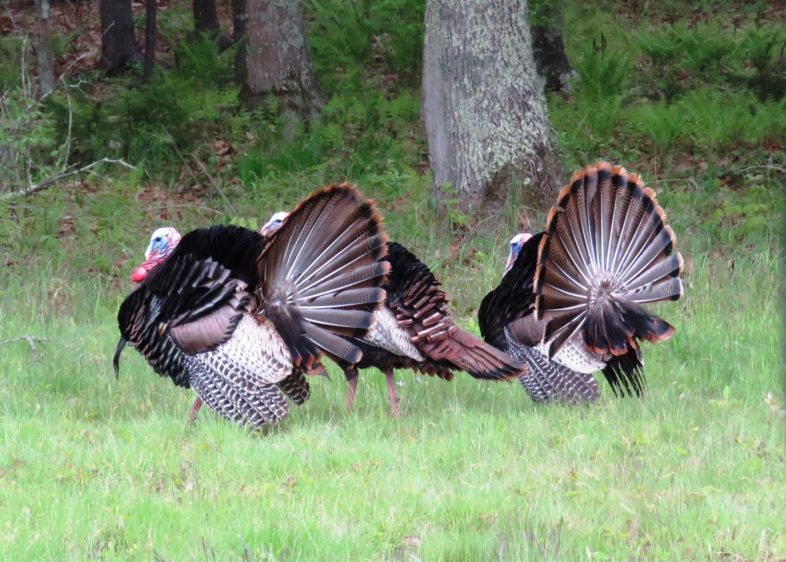
Wild Turkeys displaying at Laudholm Farms. Photo by Steve Faccio

KUDOs All. Great variety and great fun! Wish I were there. Love the commentary and pictures. Thanks for posting. Don’t forget to send in your sizes for the ‘new’ T-shirts.